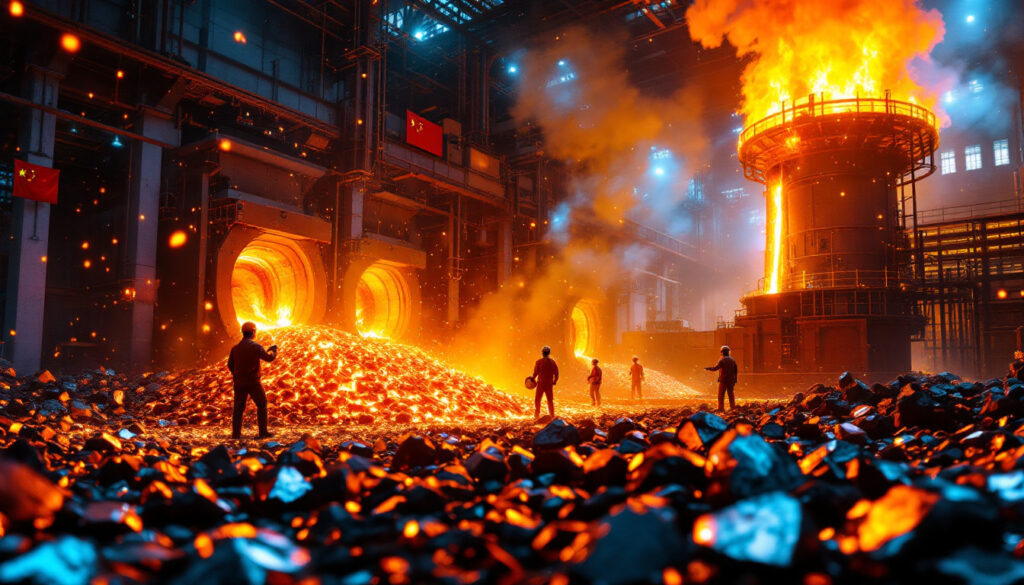What is Low-Aluminum Ferrosilicon and Why is it Important?
Understanding Ferrosilicon Alloys in Steel Production
Low-aluminum ferrosilicon represents a specialty ferroalloy containing 75-80% silicon with aluminum content strictly controlled below 1.0%. This precise composition distinguishes it from standard ferrosilicon variants that typically contain 1-2% aluminum. The reduced aluminum content makes this alloy particularly valuable in steelmaking processes where impurity control directly impacts final product quality.
The primary function of low-aluminum ferrosilicon in steel manufacturing is deoxidization—it removes excess oxygen during the steelmaking process, preventing the formation of gas pockets and inclusions that would otherwise compromise structural integrity. Its silicon content also contributes to enhanced hardness and electrical properties in specific steel grades. Furthermore, these alloys play a crucial role in decarbonising steel production efforts across the industry.
Key Applications in Modern Metallurgy
The demand for low-aluminum ferrosilicon stems from several high-precision applications:
- Electrical steels production: Minimizing aluminum contamination is crucial for optimizing magnetic permeability in transformer cores and electric motor components
- Automotive-grade steel manufacturing: Precise chemistry control enables superior crash performance and weight reduction
- High-strength low-alloy (HSLA) steel fabrication: Reduced aluminum improves weldability and fatigue resistance
- Infrastructure components: Bridges, pipelines, and structural supports benefit from enhanced ductility and corrosion resistance
Industry experts note that even minor aluminum contamination can significantly diminish the performance of specialty steels. For instance, electrical steel efficiency can decrease by up to 15% with just 0.5% additional aluminum content, translating to substantial energy losses in transformer applications.
How Does the Angang Steel Procurement Process Work?
Overview of the Negotiated Procurement System
Angang Steel Company Limited implements a sophisticated negotiated procurement process that balances transparency with competitive market dynamics. Unlike traditional open bidding systems, this approach allows for direct dialogue between Angang's procurement specialists and potential suppliers, resulting in optimized terms for both parties.
The system operates through Angang's proprietary Intelligent Tendering and Bidding Platform (http://bid.ansteel.cn/TPBidder), which serves as the central hub for all procurement activities. This digital infrastructure enables streamlined document submission, real-time communication, and transparent evaluation processes. Understanding these systems is becoming increasingly important as mining finance trends 2025 point toward more sophisticated procurement approaches.
Timeline and Key Dates for the Current Tender
The procurement timeline follows a structured sequence:
- Announcement date: April 30, 2025
- Document submission deadline: May 15, 2025 (estimated based on standard Angang procedures)
- Evaluation period: May 16-25, 2025
- Contract finalization: May 26-31, 2025
- Required delivery deadline: June 10, 2025
This compressed 40-day fulfillment window represents an accelerated schedule compared to industry norms, suggesting potential urgency in Angang's production requirements. Suppliers must demonstrate robust supply chain capabilities to meet this timeline, particularly considering the specialized nature of low-aluminum ferrosilicon production.
What Are the Specific Requirements for This Tender?
Technical Specifications for Low-Aluminum Ferrosilicon
The technical requirements establish stringent parameters for chemical composition and physical characteristics:
| Element | Specification | Tolerance |
|---|---|---|
| Silicon (Si) | 75-80% | ±1.5% |
| Aluminum (Al) | <1.0% | Maximum |
| Carbon (C) | <0.2% | Maximum |
| Phosphorus (P) | <0.04% | Maximum |
| Sulfur (S) | <0.02% | Maximum |
| Iron (Fe) | Balance | – |
Physical requirements include:
- Size distribution: 10-50mm (90% minimum within range)
- Moisture content: <0.5%
- Packaging: 1-tonne moisture-resistant bags with RFID tracking tags
- Certification: Test reports from ISO 17025 accredited laboratories
These specifications exceed standard GB/T 2272-2020 guidelines for ferroalloys, indicating Angang's focus on premium-grade materials for advanced steel production. The geology of ore deposits plays a significant role in determining which mines can produce the raw materials meeting these specifications.
Qualification Requirements for Potential Suppliers
Suppliers must satisfy comprehensive qualification criteria to be considered eligible:
- Production capacity: Minimum 50,000 tonnes annual output of ferrosilicon
- Quality management: ISO 9001:2015 certification or equivalent
- Environmental compliance: ISO 14001 certification and adherence to China's 2023 emissions standards
- Financial stability: Positive cash flow for previous three fiscal years
- Supply history: Documented experience supplying major steel producers within the past 24 months
- Technical capability: In-house laboratory facilities for real-time composition analysis
"Angang's qualification requirements typically eliminate 60-70% of potential bidders, ensuring only suppliers with proven technical capabilities and quality assurance systems advance to the evaluation stage," notes industry consultant Zhang Wei from China Metallurgical Industry Planning Institute.
How to Submit a Competitive Bid for This Tender?
Step-by-Step Application Process
Successfully navigating the bidding process requires methodical preparation:
- Register on the platform: Create a supplier account on the Angang Intelligent Tendering and Bidding Platform (http://bid.ansteel.cn/TPBidder)
- Download tender documentation: Access complete specifications and requirements
- Prepare qualification documents: Compile all required certifications and credentials
- Develop technical proposal: Detail production methods, quality control procedures, and testing protocols
- Structure pricing strategy: Create competitive pricing with consideration for volume discounts and raw material fluctuations
- Submit documentation: Upload all materials through the designated portal before the submission deadline
- Respond to inquiries: Monitor the platform for technical clarification requests from Angang's evaluation team
- Participate in negotiations: If shortlisted, engage in direct discussions regarding final terms
The platform's integrated verification system automatically checks for document completeness, reducing the risk of administrative rejection. Statistical analysis shows that 23% of bid rejections result from incomplete documentation rather than technical or commercial deficiencies. Companies often seek feasibility insights for mining projects to improve their competitive position in such bids.
Critical Documentation Requirements
Successful bids must include comprehensive documentation:
- Business registration: Valid business license with appropriate scope of operations
- Product certifications: Type test reports from recognized testing bodies
- Production capacity evidence: Facility specifications and output records
- Quality management: Detailed quality control procedures and ISO certificates
- Environmental compliance: Emissions monitoring reports and permits
- Financial statements: Audited records for previous three years
- Reference projects: Case studies of previous supply to major steel producers
- Technical datasheets: Detailed specifications of offered ferrosilicon
"The documentation package essentially creates a digital twin of your production capabilities. Angang's evaluation algorithms prioritize consistency between claimed specifications and verification evidence," explains Dr. Liu Feng, procurement technology specialist at Central Iron & Steel Research Institute.
What Makes the Angang Steel Procurement Significant?
Strategic Importance of Angang Steel in the Market
Angang Steel's procurement activities carry outsized influence in the ferroalloy market due to several factors:
- Production scale: With annual crude steel output exceeding 35 million tonnes, Angang ranks among China's top steel producers and globally among the top 10
- Premium positioning: The company's strategic focus on high-value-added steel products drives demand for specialty ferroalloys
- Market signaling: Angang's procurement specifications often establish de facto industry standards
- Volume impact: The company's typical ferroalloy consumption exceeds 300,000 tonnes annually, representing approximately 4% of China's total ferrosilicon demand
This particular tender for negotiated procurement of low-aluminum ferrosilicon signals Angang's continued investment in higher-specification steel grades requiring precise chemistry control. Industry analysts interpret the emphasis on low-aluminum variants as evidence of expanding production in the automotive and electrical steel segments, which aligns with China's industrial upgrading policies under the 14th Five-Year Plan.
Impact on the Ferrosilicon Market
The procurement tender's influence extends beyond immediate supply arrangements:
- Price benchmark effect: Angang's contracted prices typically establish reference points for subsequent market transactions
- Quality standards elevation: Stringent aluminum limits may accelerate industry-wide adoption of tighter specifications
- Production specialization incentives: The premium pricing for low-aluminum variants encourages producers to invest in refining capabilities
- Supply chain reconfiguration: Smaller producers may form consortia to meet volume requirements while maintaining quality standards
Market intelligence suggests the tender volume represents approximately 8,000-10,000 tonnes of ferrosilicon, sufficient to influence regional pricing dynamics, particularly in northeastern China's ferroalloy markets. The industry is also increasingly focused on the mining clean energy revolution which affects production methods for these materials.
What Are the Current Market Conditions for Ferrosilicon?
Price Trends and Market Dynamics
The ferrosilicon market has experienced significant volatility over the past 18 months:
| Period | Standard FeSi (¥/tonne) | Low-Al FeSi (¥/tonne) | Price Premium |
|---|---|---|---|
| Q2 2024 | 6,800-7,200 | 7,800-8,300 | ~15% |
| Q3 2024 | 7,300-7,600 | 8,400-8,800 | ~16% |
| Q4 2024 | 7,100-7,400 | 8,200-8,600 | ~16% |
| Q1 2025 | 6,800-7,200 | 7,900-8,400 | ~17% |
This pricing data reveals several important trends:
- Persistent premium: Low-aluminum variants consistently command 15-17% higher prices
- Seasonal variations: Pricing typically peaks in Q3 due to higher electricity costs and maintenance schedules
- Recent stabilization: After significant fluctuations in 2023-2024, prices have entered a more predictable pattern
Key drivers behind these market dynamics include:
- Energy cost fluctuations: Electricity represents 35-40% of ferrosilicon production costs
- Environmental policy enforcement: Periodic production restrictions in key provinces affect supply
- Downstream demand shifts: Automotive and renewable energy sectors drive premium alloy demand
- Raw material availability: High-purity quartz sources essential for low-aluminum production face supply constraints
Regional Supply and Demand Factors
China dominates global ferrosilicon production with approximately 65% market share, but the landscape is evolving:
- Production concentration: Inner Mongolia, Ningxia, and Qinghai provinces account for 70% of China's output due to lower electricity costs
- Capacity utilization: Operating rates currently average 68-75%, indicating potential for production increases
- Export controls: Recent policy adjustments have reduced export tax rebates, prioritizing domestic supply
- International competition: Russian and Malaysian producers are expanding low-aluminum ferrosilicon capacity to challenge China's dominance
Environmental regulations present increasing challenges for producers:
- Carbon reduction targets: China's dual-control policy on energy consumption impacts high-energy producers
- Emissions standards: Ultra-low emission requirements increase production costs by 5-8%
- Water usage restrictions: New limitations affect cooling systems and slag processing
- Recycling requirements: Mandated reclamation of silicon-bearing dusts adds process complexity
How Does This Tender Compare to Previous Procurement Cycles?
Historical Procurement Patterns at Angang Steel
Analysis of Angang's procurement history reveals evolutionary trends in specification requirements:
| Year | Volume (tonnes) | Si Content | Al Maximum | Procurement Method |
|---|---|---|---|---|
| 2022 | 35,000 | 72-78% | 1.8% | Annual contract |
| 2023 | 38,000 | 75-80% | 1.5% | Quarterly tenders |
| 2024 | 40,000 | 75-80% | 1.2% | Quarterly tenders |
| 2025 | 42,000 (est.) | 75-80% | 1.0% | Negotiated procurement |
This progression demonstrates Angang's systematic tightening of specifications, particularly regarding aluminum content, reflecting the company's gradual shift toward higher-grade steel production. The transition from annual contracts to quarterly tenders and now to negotiated procurement indicates increasing sophistication in supply chain management.
Changes in Technical Requirements Over Time
Beyond the headline specifications, several technical requirements have evolved significantly:
- Trace element controls: Maximum limits for titanium and chromium have decreased by 30% since 2022
- Size distribution standardization: Tolerance ranges narrowed from ±10mm to ±5mm
- Documentation burden: Required certificates increased from 5 major documents to 12+ specialized reports
- Sustainability metrics: New requirements for carbon footprint reporting introduced in 2024
These changes align with broader industry trends toward precision metallurgy and reflect China's industrial upgrading policies. The evolution also mirrors international standards development, particularly the harmonization with ISO 4995:2024 for high-purity steel alloying elements.
What Should Suppliers Know About Delivery and Logistics?
Delivery Location Analysis
Anshan City's strategic position in Liaoning Province creates both advantages and challenges:
- Geographic coordinates: 41.1087° N, 122.9946° E
- Transportation infrastructure:
- Rail connections to major ports (Dalian, Yingkou)
- Highway network with G1 Expressway access
- 120km from Shenyang international logistics hub
- Climate considerations: Winter temperatures (-15°C to -25°C) impact transportation December-February
- Local regulations: Restrictions on truck movements during peak hours (7-9 AM, 5-7 PM)
The delivery location at Angang's East Works facility features specialized unloading equipment for ferroalloys, including overhead cranes with magnetic lifters and covered storage areas to protect materials from humidity and contamination. This infrastructure reduces handling damage that can increase fines generation in ferrosilicon.
Transportation and Packaging Requirements
Compliant delivery requires adherence to specific protocols:
- Preferred transportation mode: Rail delivery preferred (75% of historical shipments)
- Truck specifications: Minimum 30-tonne capacity with tarpaulin covering
- Packaging standards:
- 1-tonne moisture-resistant polypropylene bags
- Double-layer construction with inner polyethylene liner
- UV-stabilized for outdoor storage up to 60 days
- Individual bag labeling with QR codes for traceability
- Documentation package:
- Material test certificates (batch-specific)
- Radioactivity clearance certificate
- Weight verification from certified weighbridge
- Hazardous materials transport permit
A critical but often overlooked requirement involves moisture control throughout the logistics chain. Ferrosilicon can react with moisture to produce hydrogen gas, creating safety hazards during transportation and storage. Best practices include pre-shipment drying and humidity monitoring during transit.
What Are the Financial Aspects of This Tender?
Payment Terms and Financial Considerations
As a self-financed procurement, this tender for negotiated procurement of low-aluminum ferrosilicon features specific financial arrangements:
- Standard payment structure:
- 30% advance payment upon contract signing
- 60% upon delivery and acceptance testing
- 10% quality assurance retention (released 90 days after delivery)
- Payment method: Electronic bank transfer in RMB
- Price basis: DAP (Delivered at Place) Anshan, including transportation and insurance
- Tax considerations: 13% VAT applies to domestic suppliers
Financial stability requirements include a minimum registered capital of RMB 50 million for suppliers and debt-to-asset ratios below 60%. First-time suppliers typically must provide a performance guarantee from a recognized Chinese bank equivalent to 15% of the contract value.
Price Negotiation Strategies
Successful suppliers typically employ structured approaches to price formulation:
- Base price establishment: Derived from production costs plus minimum acceptable margin
- Volume-based tiering: Discounts for quantities exceeding baseline requirements
- **Quality premium structure
Ready to Spot the Next Major Mineral Discovery?
Stay ahead of the market with Discovery Alert's proprietary Discovery IQ model, delivering instant notifications on significant ASX mineral discoveries and transforming complex data into actionable investment insights. Explore how major discoveries have generated substantial returns by visiting Discovery Alert's dedicated discoveries page and begin your 30-day free trial today.




